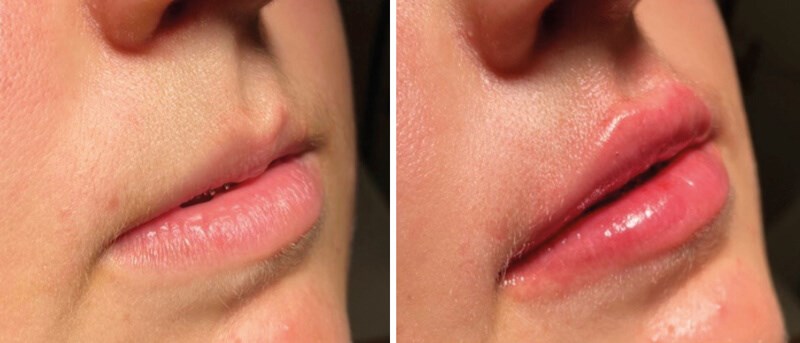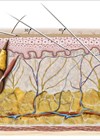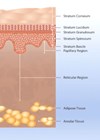Marta Duarte takes us through her technique for lip augmentation, from patient selection to aftercare.
Lips are considered extremely important for maintaining the overall facial aesthetics. It is no surprise that today, lip augmentation procedures have become the most sought-after aesthetic treatment.
Soft tissue augmentation using hyaluronic acid (HA) dermal fillers has a remarkable ability to undo the consequences of ageing, such as photodamage, smoking, as well as peripheral rhytides, not to mention increasing the patient’s self-confidence. Genetically thin lips, cosmetic asymmetries, and prominent ‘marionette lines’ can also be corrected non-surgically to help patients achieve results that meet their individual needs and anatomically adhere to ideal proportions.
Lip augmentation using hyaluronic acid dermal fillers is a non-surgical, non-invasive procedure that take 15 minutes on average. The results are immediate, with minimal side-effects or adverse reactions and efficient outcomes.
Patient selection
While experience and knowledge of a product should result in a successful treatment, the outcome may be unexpected with an unsuitable patient. Careful patient selection is an absolute must. A detailed consultation where benefits, limitations and potential unfavourable results are summarised is necessary pre-treatment. I make sure that I counsel my patients, discussing the immediate aftermath of lip augmentation. I also encourage them to disclose their full medical history of any surgical or non-surgical procedures, fears or concerns, in order to ensure the entire experience is hassle-free and results are as per expectations.
Besides the concerns outlined above, the ideal candidate for lip filling is one whose lip structure is inherently thin or patients whose volume has diminished with age. It is essential that the patient does not have any facial dermal infections, uncontrolled blood clotting disorders, uncontrolled diabetes, HA sensitivity, and has not taken blood-thinning medication (ibuprofen or aspirin) up to two weeks prior to the procedure.
Preparation
It is crucial to understand the patient’s needs. Some patients could be looking for subtle corrections while others for enhanced definition or fullness. I always make sure to identify the exact requirement and advise the best course of treatment in advance.
Before pictures are taken, previous procedures are discussed and the respective consent form, with all the possible side-effects listed, is signed by the patient.
Lip augmentation is performed under local anaesthesia or by applying anaesthetic creams, depending on the patient’s pain tolerance. My personal preference is to use dental block with infraorbital and mental nerve block, as frequently with anaesthetic creams patients are not comfortable enough and this may result in an inaccurate treatment.

Patient before and after treatment.
Procedure (technique of injection)
For optimal lip augmentation results, it is necessary to maintain proper contour and balance between the upper and lower lips. The golden ratio for female lips is the ratio of 1.0 upper lip for 1.6 of lower lip (for most ethnicities). It is imperative to correct lips while maintaining the natural ratio and proportion. In my experience, a deflating vermilion is one of the biggest patient concerns, comprising of drooping angles of the mouth. More often than not, it is the upper lip that becomes the focus of the treatments rather the lower lip.
The technique for injecting HA fillers into the lips involves serial punctures and linear threading, preferably retrograde. These can be applied either individually or in combination based on the patient’s needs.
Upon assessing the lips, it can be ascertained if the lips require superficial or deep filling. The best approach is an individual approach, paying attention to each movement of the needle and keeping in mind the patient’s aesthetic desires. For especially thin lips, volume augmentation with deeper-placed filler is advised, followed by surface corrections to add definition. Contrarily, for enhancement purposes, a superficially placed filler with emphasis on the vermilion border is better.
I prefer to use a 27G cannula instead of a needle as its blunt tip minimises the trauma and reduces any risk of penetrating through the vessels. It also allows access to each area of the lip while minimising the need for skin penetration. In most cases, only one point is required on each side the lip. In my opinion, filler should not be injected from the border of the lips unless an elongated appearance to the lips is required or in the case of attempting to provide structural support to the augmented lips. In the end, I ensure that the lips are evenly augmented by requesting that the patient smiles and puckers their mouth, which can confirm that the curvature is even and the proportions are maintained.
In my experience, I have been able to obtain optimal results with Hyaprof Balance, a polydensified monophasic dermal filler that gives a natural look and ensures long-lasting results.
Aftercare
Immediately after treatment, swelling or bruising may appear even when using the correct technique. Ice-packs can be applied to the area to minimise any discomfort. You may recommend the patient avoids additional treatment, lip exfoliation and extreme temperatures within 24 hours of the treatment.
Declaration of competing interests: None declared.
COMMENTS ARE WELCOME








